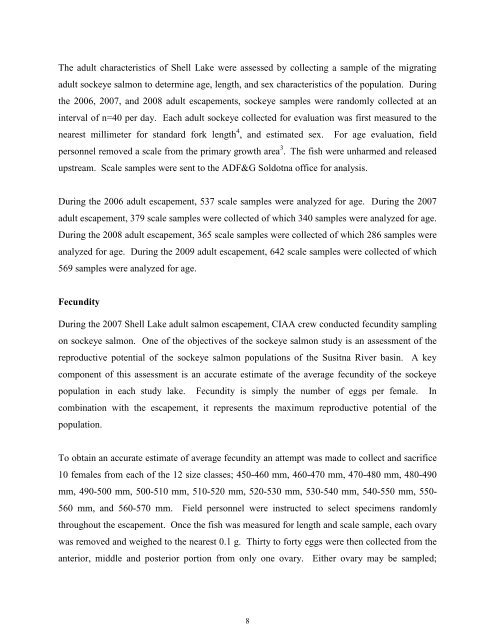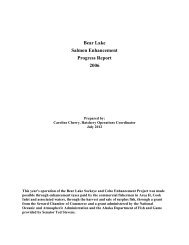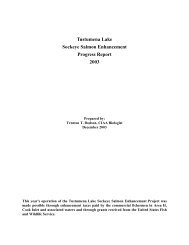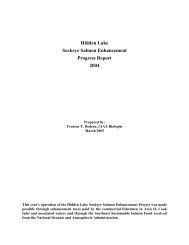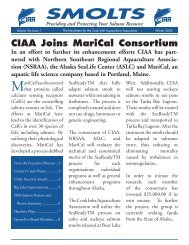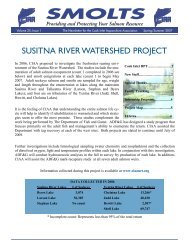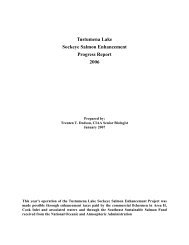Chenik Lake - Cook Inlet Aquaculture Association, Kenai, Alaska
Chenik Lake - Cook Inlet Aquaculture Association, Kenai, Alaska
Chenik Lake - Cook Inlet Aquaculture Association, Kenai, Alaska
You also want an ePaper? Increase the reach of your titles
YUMPU automatically turns print PDFs into web optimized ePapers that Google loves.
The adult characteristics of Shell <strong>Lake</strong> were assessed by collecting a sample of the migrating<br />
adult sockeye salmon to determine age, length, and sex characteristics of the population. During<br />
the 2006, 2007, and 2008 adult escapements, sockeye samples were randomly collected at an<br />
interval of n=40 per day. Each adult sockeye collected for evaluation was first measured to the<br />
nearest millimeter for standard fork length 4 , and estimated sex. For age evaluation, field<br />
personnel removed a scale from the primary growth area 3 . The fish were unharmed and released<br />
upstream. Scale samples were sent to the ADF&G Soldotna office for analysis.<br />
During the 2006 adult escapement, 537 scale samples were analyzed for age. During the 2007<br />
adult escapement, 379 scale samples were collected of which 340 samples were analyzed for age.<br />
During the 2008 adult escapement, 365 scale samples were collected of which 286 samples were<br />
analyzed for age. During the 2009 adult escapement, 642 scale samples were collected of which<br />
569 samples were analyzed for age.<br />
Fecundity<br />
During the 2007 Shell <strong>Lake</strong> adult salmon escapement, CIAA crew conducted fecundity sampling<br />
on sockeye salmon. One of the objectives of the sockeye salmon study is an assessment of the<br />
reproductive potential of the sockeye salmon populations of the Susitna River basin. A key<br />
component of this assessment is an accurate estimate of the average fecundity of the sockeye<br />
population in each study lake. Fecundity is simply the number of eggs per female. In<br />
combination with the escapement, it represents the maximum reproductive potential of the<br />
population.<br />
To obtain an accurate estimate of average fecundity an attempt was made to collect and sacrifice<br />
10 females from each of the 12 size classes; 450-460 mm, 460-470 mm, 470-480 mm, 480-490<br />
mm, 490-500 mm, 500-510 mm, 510-520 mm, 520-530 mm, 530-540 mm, 540-550 mm, 550-<br />
560 mm, and 560-570 mm. Field personnel were instructed to select specimens randomly<br />
throughout the escapement. Once the fish was measured for length and scale sample, each ovary<br />
was removed and weighed to the nearest 0.1 g. Thirty to forty eggs were then collected from the<br />
anterior, middle and posterior portion from only one ovary. Either ovary may be sampled;<br />
8


